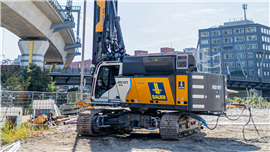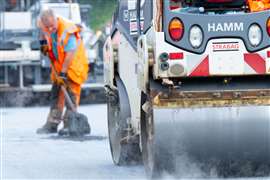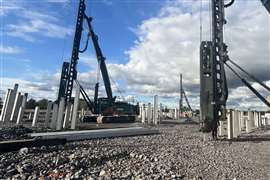Hybrid pile driver deployed on train station project
07 November 2024
Bauer – a German-based construction machinery manufacturer – said its eRG 19 T hybrid pile driver from subsidiary RTG Rammtechnik (RTG) made its first deployment for foundation work on the Port ONE Berlin building project in Berlin’s Europacity urban neighbourhood.
 A Bauer and RTG Rammtechnik eRG 19 T hybrid pile driver on the site of the future Port ONE Berlin building in Germany. (Image: Bauer)
A Bauer and RTG Rammtechnik eRG 19 T hybrid pile driver on the site of the future Port ONE Berlin building in Germany. (Image: Bauer)
The structure is designed to rise 55m and cover an expanse of 32,000m2. The lower floor will serve as the main station for the Friedrich-Krause-Ufer train line.
The structure will also provide access to the elevated S-Bahn-ring and will include office and commercial spaces for production and service companies, restaurants, artists’ studios and more.
Lars Heilfort, project manager at Bauer Spezialtiefbau, said the hybrid was selected to offset noise and emissions within the dense urban site. “By using the new eRG 19 T hybrid, we demonstrate that construction sites can be efficient as well as quiet and low on emissions,” he said.
Bauer said the inaugural run revealed that the hybrid operation of the eRG 19 T reduced diesel consumption by up to 68% (-17 litres-per-hour), which translates into 45kg-less CO₂ per-hour. Projected over one month, Bauer estimated a 7-tonne CO₂ savings.
Pit excavation for the building’s foundation started in November 2022, Bauer said.
The company said it was tasked with constructing an “impermeable excavation pit to create space for underground garages and equipment rooms on the basement levels.
“Over a total of two construction phases, a combination of mixed-in-place method, a pile wall and an LWS [lightweight sand] silicate gel base… is used,” said Bauer, noting it also developed the LWS gel.
On the process, Bauer said that the first step was to replace contaminated soil and construct foundation piles to increase load-bearing capacity.
“Upon completion of the excavation wall, vibration drilling with the eRG 19 T hybrid was carried out to specified grid spacing,” added the firm. “These were then filled with insulation, grout pipes with valves were installed and silicate gel injected to create a stable sealing horizon.
“This way, the excavation pit stays dry and is ready for the subsequent specialist foundation engineering works.”
Specs and details on the RTG eRG 19 T hybrid pile driver
 Bauer and RTG’s eRG 19 T hybrid pile driver. (Image: Bauer)
Bauer and RTG’s eRG 19 T hybrid pile driver. (Image: Bauer)
The eRG 19 T hybrid drive is said to combine the power of a 430-kW diesel engine with the precision of an 88-kW electric motor. Bauer said the combination of the two drives makes it possible to keep efficiency at a consistently high level despite stringent emission requirements, like was the case at the train-line-adjacent project.
“The diesel engine works at reduced capacity, aided by the supporting electric motor, resulting in a significant reduction in both CO₂ emissions as well as noise levels,” said Bauer. “It masters even demanding impact driving tasks of the next higher equipment group without any problems. The electric motor flexibly takes on auxiliary work – efficiently and customer-fit.”
The unit also features a modular design, which Bauer said further supported versatility.
“The hybrid attachment at the rear contains all electronic components, while the electric motor is easy to service with its integration into the quadruple transfer case at the upper carriage,” Bauer noted. “In addition, the maximum connected mains load can be adjusted directly in the operator’s cab, depending on availability on site.”
Data – such as electricity consumption and performance – can be accessed any time via the driver display, the company added.
More on the Port ONE Berlin project
Located near two sets of train tracks and a motorway, the tight site (13,000m2) of Port ONE Berlin will be mostly occupied by what will become a roughly 15-storey mid/high-rise for office and commercial spaces.
Berlin-based Nöfer Architekten designed the building for real estate developer Optima-Aegidius-Firmengruppe. Details on general contractor and builders for the building construction are not yet available.
The building is scheduled for completion by next year.
CONTÁCTESE CON EL EQUIPO







